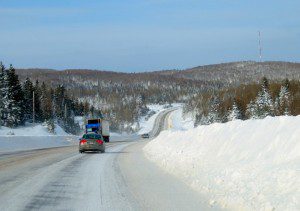 Whether you’re driving in snow, on slick roads, or on icy-slushy roads, winter driving in Canada is never dull. It’s an adventure that requires skill, focus, and all of your senses.
Whether you’re driving in snow, on slick roads, or on icy-slushy roads, winter driving in Canada is never dull. It’s an adventure that requires skill, focus, and all of your senses.
For starters, find out the weather forecast for all the areas you will be driving. If you are experiencing terrible weather or they are forecasting bad weather, consider delaying your trip.
In snowy or icy conditions, you’ll be much safer if you forget about rushing. Allow extra driving time. Drive slower than posted speed limits, which are only for ideal travel conditions. Reduce speed when you approach intersections that are covered with snow or ice, and when approaching a bridge (bridges can ice before the rest of the road). Steer with smooth and precise movements, not quick and jerky. Don’t be in a hurry to pass other vehicles; wait until it is safe to do so. In addition, avoid using your cruise control so you can regulate your speed more easily.
The old driver’s education tip of keeping a “space cushion” around your vehicle is especially important in winter road conditions. At the speed of 60 km/h, where you would normally leave a 45 metres (140 ft) gap, that distance should be increased to 80 metres (over 260 ft) on an icy road surface. As a general rule of thumb, leave twice the following distance as you would on dry roads. Stay in the right-hand lane except when passing, and use turn signals when changing lanes.
Drive using your low-beam headlights. They are brighter than daytime running lights. Using low-beam lights also means you have activated the taillights, making your vehicle more visible. Winter driving requires optimum visibility and control.
Always wear your seatbelt. A surprising number of fatalities still happen because people fail to buckle up.
Winter is a time to expect the unexpected, so be flexible. Consider getting off the road before getting stranded in inclement weather.
Skid control
When you’re losing control of your vehicle on a slippery road, do not panic. Immediately focus on where you want your vehicle to go, then look and steer in that direction. Do not brake or accelerate. If you use manual transmission, declutch. Shift to neutral in an automatic, but if you can’t do it immediately, don’t touch the transmission gear.
When you’re driving (and not skidding), on a slippery road, the way to brake depends on the type of brakes your vehicle has. If you don’t have anti-lock brakes, use the heel-to-toe method repeatedly until you come to a full stop. This means keeping your heel on the floor and using your toes to press the brake pedal firmly just short of locking up the wheels, releasing the pressure on the pedal, and pressing again in the same way. This is repeated until you come to a full stop. When braking with anti-lock brakes, also use heel-and-toe method, but do not remove your foot from the brake pedal until the vehicle comes to a complete stop.
For further information on winter driving, including what to do if you’re stuck or stranded in the snow, visit OSH Answers online atwww.ccohs.ca/oshanswers/safety_haz/icesnow.html
Discussion
No comments yet.